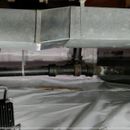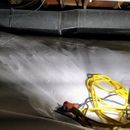Blower door interaction with crawl space liner
When using a blower door to depressurize a house, I’m wondering if anyone else has seen a crawl space liner balloon up a couple feet. This crawl space has rigid foam on the exterior walls and in the rim joist bays with canned foam used to air seal the cracks/gaps. The rigid foam on the walls is connected to the sill plate and not the block wall foundation (it’s a couple feet tall and not perfectly plumb everywhere). There are two old, no longer in use, crawl space vents behind the foam. In addition, there is a plastic vapor barrier taped at the seams and perimeter caulked to the block walls and foam. To elaborate on the ballooning, this crawl space has an L shape (29′ length and 11’ to 14’ wide). Before and after pictures are included to help visualize how the plastic liner became inverted. If there are any concerns, I am really wondering how one would go about improving this.
Lastly, it’d be nice to deal with any leakage. I’m pondering that air is travelling through one of the old crawl space vents around the rigid foam.
Some other info:
The blower door result was 4580 cfm @ 50 Pa. (I imagine quite a bit of this leakage comes from the giant flue pipe used for the original boiler from when the house was built in 1952.)
Since the volume of the conditioned space is about 32,450 ft^2, I believe this results in 8.47 ACH50 (air changes per hour at 50 Pa).
I do have access to a blower door.
This house is also in the process of mitigating radon and has plans to add suction under this crawl space liner.
The basement has another smaller crawl space (with unsealed plastic on floor) and around 1000 ft^2 of basement with 8′ ceiling height.
The basement door had quite the resistance when trying to close it during the blower door test.
Climate zone 5.
GBA Detail Library
A collection of one thousand construction details organized by climate and house part











Replies
Interesting!
To confirm, you are depressurizing, and not pressurizing?
What stage is the radon mitigation at? Is there a pipe that penetrates the poly layer on the floor? Where does it terminate?
Depressurizing--blowing air out of the house.
There is a radon mitigation system that is not adequately working and in the concrete slab of basement with 8' ceilings. The initial goal for radon is to add suction points in each crawl space and better seal the sump. There is currently no pipes penetrating the sealed crawl space liner.
Unless you are willing to ballast the plastic with sand or pea gravel, I would reverse the flow of the fan and use positive pressure for your testing and leak location efforts.
Seems to me what you are seeing would not be unexpected in homes with plastic liners that are well sealed.
Walta
I know for air tightness testing the standard is to pressurize. I am unfamiliar with depressurizing.
With a pressurized house you can use a "smoke gun" and or thermal imaging to chase down the air leaks.
Air can travel in complex 3-dimensional pathways, hard to guess what or where the issue is. Air sealing the old crawl vents (from the outside maybe?) may be a good place to start.